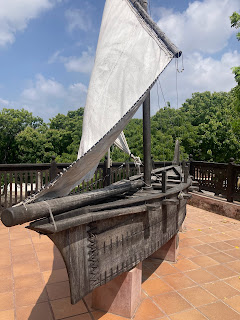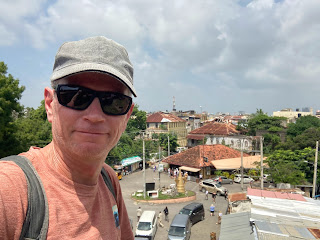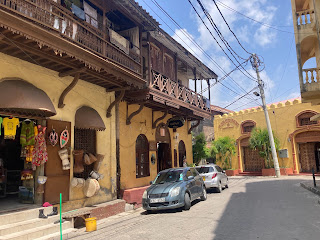December 21st, 2023
One of the
main historical sites to see in the port city of Mombasa, is Fort Jesus. It was built between 1593 and 1596 by order
of the King of Spain and Portugal to guard the Old Port of Mombasa. The fort was lost and recaptured by the
Portuguese nine times over the years. In
1895, the British turned it into a prison and finally in 2011, it was declared
a World Heritage Site by UNESCO. It is
considered one of the best preserved examples of a 16th century Portuguese
military fort.
I took an Uber
to get from Bamburi to the fort which is located on Mombasa Island, the old
part of the city. Almost immediately, a
young Muslim woman wearing a hijab approached me and asked if I wanted a
guide. I was a bit hesitant as I wasn’t
sure if I wanted/needed a guide and whether she was legit. She did have an ID badge that seemed valid,
and she seemed nice, kind of reminded me a bit of my guide in Kampala at the
Gaddafi Mosque (although she turned out to be not as funny or engaging as that
guide).
The entrance to the fort:
I opted to
use Samara’s services to tour the fort and perhaps to visit some of the old
town afterwards. Interestingly had I decided
to go it alone, I would have had troubles just getting into the fort. For some reason they only accepted M-Pesa,
the method to pay for things with your phone, which I did not have. So Samara paid for me and added that to my “bill”.
This is a model of the fort. Supposedly, this is why it is called the "Jesus Fort"...because it so obviously looks like Jesus doesn't it?!? Sorry, I couldn't get the photo to stay rotated upright on this site. His head is on the left, his two arms, then the big rectangular body and the legs. Yup, looks like the son of God to me!
The tour
around the fort only took about 40 minutes.
There were a few nice views from the parapet, looking out to the Indian
Ocean and the bay where ships used to enter to the Old Port. Samara explained some of the Omani influence
over the years and there were a few rooms with historic outfits from Oman, pictures
of past sultans and the odd weapon, like a gun, spear and hand shield.
Leaving the
fort, we walked for about 20 minutes around the nearby area with narrow streets
and old buildings, some sporting fancily carved wooden doors or ornate balconies. One point of interest she had previously mentioned
was the Old Port, but it was hardly worth it.
First off, all you could see was a gate and secondly, you couldn’t even
take any pictures in that area due to “security concerns”.
We hopped
in a tuk tuk (back in the land of tuk tuks!) and drove to the Mombasa Tusks, a monument
that was built in the 1950s to commemorate the visit by Queen Elizabeth II. Now it is just a tourist stop, a place to
take a few pics with these two pairs of giant aluminum tusks which straddle over
the median lined road to form a big “M” (not the McDonald’s kind) for Mombasa. I got my photos, and we were back in the tuk
tuk to head to the spice market.
Can you see me?
Tuk tukking to through the narrow market streets:
After a brief walk around the market, that was the end of the tour with Samara. I felt it was a little overpriced for what we did, but I definitely got more out of the visit to Old Mombasa than if I had walked it alone.

























No comments:
Post a Comment